《药理学》课程教学资源(作业习题)习题集三(英文,习题)
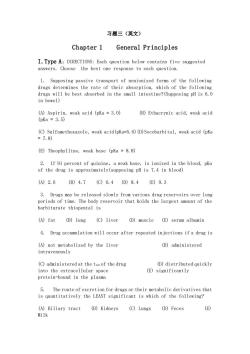
习题三(英文) Chapter 1 General Principles I.Type A:DIRECTIONS:Each question below contains five suggested answers.Choose the best one response to each question. 1.Supposing passive transport of nonionized forms of the following drugs determines the rate of their absorption,which of the following drugs will be best absorbed in the small intestine?(Supposing pH is 6.0 in bowel) gnaiao-a0 (B)Ethacrynic acid,weak acid (C)Sulfamethoxazole,weak acid(pKa=5.6)(D)Secobarbital,weak acid (pKa =7.8) (E)Theophylline,weak base (pKa =8.8) 2.If 91 percent of quinine,a weak base,is ionized in the blood,pKa of the drug is approximately(supposing pH is 7.4 in blood) (A)2.6 (B)4.7 (C)6.4(D)8.4 (E)9.3 3.Drugs may be released slowly from various drug reservoirs over long periods of time.The body reservoir that holds the largest amount of the barbiturate thiopental is (A)fat (B)lung (C)liver (D)muscle (E)serum albumin 4.Drug accumulation will occur after repeated injections if a drug is (A)not metabolized by the liver (B)administered intravenously (C)administered at the t of the drug (D)distributed quickly into the extracellular space (E)significantly protein-bound in the plasma 5.The route of excretion for drugs or their metabolic derivatives that is quantitatively the LEAST significant is which of the following? (A)Biliary tract (B)Kidneys (C)Lungs (D)Feces () Milk
习题三(英文) Chapter 1 General Principles I.Type A:DIRECTIONS: Each question below contains five suggested answers. Choose the best one response to each question. 1. Supposing passive transport of nonionized forms of the following drugs determines the rate of their absorption, which of the following drugs will be best absorbed in the small intestine?(Supposing pH is 6.0 in bowel) (A) Aspirin, weak acid (pKa = 3.0) (B) Ethacrynic acid, weak acid (pKa = 3.5) (C) Sulfamethoxazole, weak acid(pKa=5.6)(D)Secobarbital, weak acid (pKa = 7.8) (E) Theophylline, weak base (pKa = 8.8) 2. If 91 percent of quinine,a weak base, is ionized in the blood, pKa of the drug is approximately(supposing pH is 7.4 in blood) (A) 2.6 (B) 4.7 (C) 6.4 (D) 8.4 (E) 9.3 3. Drugs may be released slowly from various drug reservoirs over long periods of time. The body reservoir that holds the largest amount of the barbiturate thiopental is (A) fat (B) lung (C) liver (D) muscle (E) serum albumin 4. Drug accumulation will occur after repeated injections if a drug is (A) not metabolized by the liver (B) administered intravenously (C) administered at the t1/2 of the drug (D) distributed quickly into the extracellular space (E) significantly protein-bound in the plasma 5. The route of excretion for drugs or their metabolic derivatives that is quantitatively the LEAST significant is which of the following? (A) Biliary tract (B) Kidneys (C) Lungs (D) Feces (E) Milk

6.Oxidizable drugs form a complex with and are oxidized by which of hiniron-containing pignts in the fraction of (A)Cytochrome a (B)Cytochrome b (C)Cytochrome c (D)Cytochrome cl (E)Cytochrome P-450 7.In the presence of impaired renal function,the time interval between maintenance doses needs to be lengthened for all the following antibiotics EXCEPT (A)ciprofloxacin (B)streptomycin (C)sulfisoxazole (D) chloramphenicol (E)ethambutol Questions 8-11 Drug A 200 mg was administered intravenously to a 70-kg man,The plasma concentrations of thedrugwere determined at various times after injection,as shown in the figure below
6. Oxidizable drugs form a complex with and are oxidized by which of the following iron-containing pigments in the microsomal fraction of liver? (A) Cytochrome a (B) Cytochrome b (C) Cytochrome c (D) Cytochrome c1 (E) Cytochrome P-450 7. In the presence of impaired renal function, the time interval between maintenance doses needs to be lengthened for all the following antibiotics EXCEPT (A) ciprofloxacin (B) streptomycin (C) sulfisoxazole (D) chloramphenicol (E) ethambutol Questions 8-11 Drug A 200 mg was administered intravenously to a 70-kg man, The plasma concentrations of the drug were determined at various times after injection, as shown in the figure below

8.The elimination haft-life (T1/2)of Drug A in this patient is about (A)0.4hr(B)0.8hr(C)1.5hr(D)2.3hr(E)4.0hr 9.The elimination rate constant (kc)of Drug A in this patient is (a)0.1hr(B)0.2hr(C)0.3-hr(D)0.4hr(E)0.5hr 10.The apparent volume of distribution of Drug A in this individual is about (A)1.6 liters (B)39 liters (C)59 liters (D)111 liters (E)200 liters 11.The total body clearance of the drug is (A)33.5 liters/hr (B)48.0 liters/hr (2)60.0 liters/hr (D)255.0 liters/hr (E)370.5 liters/hr 12.If a drug has an elimination half-life (t1/2)of 25 hr and 10 mg is administered intravenously every 12.5 hr,the expected average total body store of drug would be how many times greater than the 10 mg dose?
8. The elimination haft-life (T1/2) of Drug A in this patient is about (A) 0.4 hr (B) 0.8 hr (C) 1.5 hr (D) 2.3 hr (E) 4.0 hr 9. The elimination rate constant (kc) of Drug A in this patient is (A) 0.l_ 1hr (B) 0.2_ 1hr (C) 0.3_1 hr (D) 0.4_1 hr (E) 0.5_1 hr 10. The apparent volume of distribution of Drug A in this individual is about (A) 1.6 liters (B) 39 liters (C) 59 liters (D) 111 liters (E) 200 liters 11. The total body clearance of the drug is (A) 33.5 liters/hr (B) 48.0 liters/hr (2) 60.0 liters/hr (D) 255.0 liters/hr (E) 370.5 liters/hr 12. If a drug has an elimination half-life (t1/2) of 25 hr and 10 mg is administered intravenously every 12.5 hr, the expected average total body store of drug would be how many times greater than the 10 mg dose?
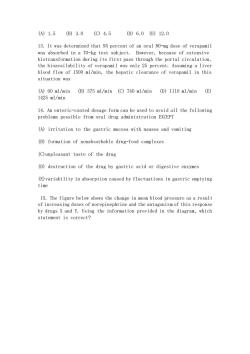
(A)1.5(B)3.0(C)4.5(D)6.0(E)12.0 13.It was determined that 95 percent of an oral 80-mg dose of verapamil was absorbed in a 70-kg test subject.However,because of extensive biotransformation during its first pass through the portal circulation, the bioavailability of verapamil was only 25 percent.Assuming a liver blood flow of 1500 ml/min,the hepatic clearance of verapamil in this situation was (A)60 ml/min (B)375 ml/min (C)740 ml/min (D)1110 ml/min (E) 1425 ml/min 14.An enteric-coated dosage form can be used to avoid all the following problems possible from oral drug administration EXCEPT (A)irritation to the gastric mucosa with nausea and vomiting (B)formation of nonabsorbable drug-food complexes (C)unpleasant taste of the drug (D)destruction of the drug by gastric acid or digestive enzymes (E)variability in absorption caused by fluctuations in gastric emptying time 15.The figure below shows the change in mean blood pressure as a result of increasing doses of norepinephrine and the antagonism of this response by drugs X and Y.Using the information provided in the diagram,which statement is correct?
(A) 1.5 (B) 3.0 (C) 4.5 (D) 6.0 (E) 12.0 13. It was determined that 95 percent of an oral 80-mg dose of verapamil was absorbed in a 70-kg test subject. However, because of extensive biotransformation during its first pass through the portal circulation, the bioavailability of verapamil was only 25 percent. Assuming a liver blood flow of 1500 ml/min, the hepatic clearance of verapamil in this situation was (A) 60 ml/min (B) 375 ml/min (C) 740 ml/min (D) lll0 ml/min (E) 1425 ml/min 14. An enteric-coated dosage form can be used to avoid all the following problems possible from oral drug administration EXCEPT (A) irritation to the gastric mucosa with nausea and vomiting (B) formation of nonabsorbable drug-food complexes (C)unpleasant taste of the drug (D) destruction of the drug by gastric acid or digestive enzymes (E)variability in absorption caused by fluctuations in gastric emptying time 15. The figure below shows the change in mean blood pressure as a result of increasing doses of norepinephrine and the antagonism of this response by drugs X and Y. Using the information provided in the diagram, which statement is correct?
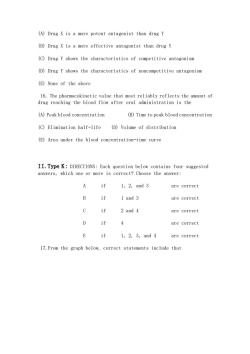
(A)Drug X is a more potent antagonist than drug Y (B)Drug X is a more effective antagonist than drug Y (C)Drug Y shows the characteristics of competitive antagonism (D)Drug Y shows the characteristics of noncompetitive antagonism (E)None of the above 16.The pharmacokinetic value that most reliably reflects the amount of drug reaching the blood flow after oral administration is the (A)Peak blood concentration (B)Time to peak blood concentration (C)Elimination half-life (D)Volume of distribution (E)Area under the blood concentration-time curve II.Type K:DIRECTIONS:Each question below contains four suggested answers,which one or more is correct?Choose the answer: A if 1,2,and3 are correct B if I and 3 are correct C if 2 and 4 are correct are correct E if 1,2,3,and 4 are correct 17.From the graph below,correct statements include that
(A) Drug X is a more potent antagonist than drug Y (B) Drug X is a more effective antagonist than drug Y (C) Drug Y shows the characteristics of competitive antagonism (D) Drug Y shows the characteristics of noncompetitive antagonism (E) None of the above 16. The pharmacokinetic value that most reliably reflects the amount of drug reaching the blood flow after oral administration is the (A) Peak blood concentration (B) Time to peak blood concentration (C) Elimination half-life (D) Volume of distribution (E) Area under the blood concentration-time curve II.Type K: DIRECTIONS: Each question below contains four suggested answers, which one or more is correct? Choose the answer: A if 1, 2, and 3 are correct B if 1 and 3 are correct C if 2 and 4 are correct D if 4 are correct E if 1, 2, 3, and 4 are correct 17.From the graph below, correct statements include that

(1)Drug A is more potent than Drug B (2)Drug A is less effective than Drug C (3)Drug B is less effective than Drug C(4)Drug A is more selective than Drug B 18.Agents that appear to act via cellular receptors include (1)Diazepam (2)Nimodipine (3)Cimetidine (4)ferrous sulfate 19.Monitoring the blood levels of a drug is particularly important if the (1)Interpatient variability is considerable (2)Therapeutic index of the drug is low (3)Biological effect is difficult to monitor (4)the drug is easily accumulated 20.Biotransformation reactions classified as nonsynthetic include which of the following? (1)Oxidation (2)Reduction (3)Hydrolysis (4)Acetylation 21.True receptors that mediate the biological actions of neurotransmitters,hormones,and drugs include certain: (1)Regulatory proteins (2)Transport protein (3)Enzymes (4) Plasma proteins 22.Some drugs are transported across lipoid membranes by facilitated diffusion.This is a process that
(1) Drug A is more potent than Drug B (2) Drug A is less effective than Drug C (3) Drug B is less effective than Drug C (4) Drug A is more selective than Drug B 18. Agents that appear to act via cellular receptors include (1) Diazepam (2) Nimodipine (3) Cimetidine (4) ferrous sulfate 19. Monitoring the blood levels of a drug is particularly important if the (1) Interpatient variability is considerable (2) Therapeutic index of the drug is low (3) Biological effect is difficult to monitor (4)the drug is easily accumulated 20. Biotransformation reactions classified as nonsynthetic include which of the following? (1) Oxidation (2) Reduction (3) Hydrolysis (4) Acetylation 21. True receptors that mediate the biological actions of neurotransmitters, hormones, and drugs include certain: (1) Regulatory proteins (2) Transport protein (3) Enzymes (4) Plasma proteins 22. Some drugs are transported across lipoid membranes by facilitated diffusion. This is a process that
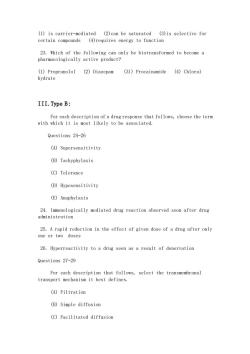
(1)is carrier-mediated (2)can be saturated (3)is selective for certain compounds (4)requires energy to function 23.Which of the following can only be biotransformed to become a pharmacologically active product? (1)Propranolol (2)Diazepam (3))Procainamide (4)Chloral hydrate III.Type B: For each description of a drug response that follows,choose the term with which it is most likely to be associated. Questions 24-26 (A)Supersensitivity (B)Tachyphylaxis (C)Tolerance (D)Hyposensitivity (E)Anaphylaxis 24.Immunologically mediated drug reaction observed soon after drug administration 25.A rapid reduction in the effect of given dose of a drug after only one or two doses 26.Hyperreactivity to a drug seen as a result of denervation Questions 27-29 For each description that follows,select the transmembranal transport mechanism it best defines. (A)Filtration (B)Simple diffusion (C)Facilitated diffusion
(1) is carrier-mediated (2)can be saturated (3)is selective for certain compounds (4)requires energy to function 23. Which of the following can only be biotransformed to become a pharmacologically active product? (1) Propranolol (2) Diazepam (3)) Procainamide (4) Chloral hydrate III.Type B: For each description of a drug response that follows, choose the term with which it is most likely to be associated. Questions 24-26 (A) Supersensitivity (B) Tachyphylaxis (C) Tolerance (D) Hyposensitivity (E) Anaphylaxis 24. lmmunologically mediated drug reaction observed soon after drug administration 25. A rapid reduction in the effect of given dose of a drug after only one or two doses 26. Hyperreactivity to a drug seen as a result of denervation Questions 27-29 For each description that follows, select the transmembranal transport mechanism it best defines. (A) Filtration (B) Simple diffusion (C) Facilitated diffusion
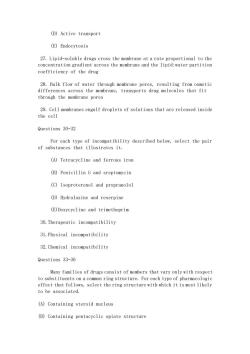
(D)Active transport (E)Endocytosis 27.Lipid-soluble drugs cross the membrane at a rate proportional to the concentration gradient across the membrane and the lipid:water partition coefficiency of the drug 28.Bulk flow of water through membrane pores,resulting from osmotic differences across the membrane,transports drug molecules that fit through the membrane pores 29.Cell membranes engulf droplets of solutions that are released inside the cell Questions 30-32 For each type of incompatibility described below,select the pair of substances that illustrates it. (A)Tetracycline and ferrous iron (B)Penicillin G and sreptomycin (C)Isoproterenol and propranolol (D)Hydralazine and reserpine (E)Doxycycline and trimethoprim 30.Therapeutic incompatibility 31.Physical incompatibility 32.Chemical incompatibility Questions 33-36 Many families of drugs consist of members that vary only with respect to substituents on a common ring structure.For each type of pharmacologic effect that follows,select the ring structure with which it is most likely to be associated. (A)Containing steroid nucleus (B)Containing pentacyclic opiate structure
(D) Active transport (E) Endocytosis 27. Lipid-soluble drugs cross the membrane at a rate proportional to the concentration gradient across the membrane and the lipid:water partition coefficiency of the drug 28. Bulk flow of water through membrane pores, resulting from osmotic differences across the membrane, transports drug molecules that fit through the membrane pores 29. Cell membranes engulf droplets of solutions that are released inside the cell Questions 30-32 For each type of incompatibility described below, select the pair of substances that illustrates it. (A) Tetracycline and ferrous iron (B) Penicillin G and sreptomycin (C) Isoproterenol and propranolol (D) Hydralazine and reserpine (E)Doxycycline and trimethoprim 30.Therapeutic incompatibility 31.Physical incompatibility 32.Chemical incompatibility Questions 33-36 Many families of drugs consist of members that vary only with respect to substituents on a common ring structure. For each type of pharmacologic effect that follows, select the ring structure with which it is most likely to be associated. (A) Containing steroid nucleus (B) Containing pentacyclic opiate structure
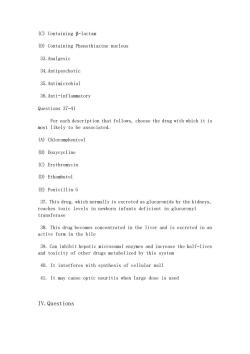
(C)Containing B-lactam (D)Containing Phenothiazine nucleus 33.Analgesic 34.Antipsychotic 35.Antimicrobial 36.Anti-inflammatory Questions 37-41 For each description that follows,choose the drug with which it is most likely to be associated. (A)Chloramphenicol (B)Doxycycline (C)Erythromycin (D)Ethambutol (E)Penicillin G 37.This drug,which normally is excreted as glucuronide by the kidneys, reaches toxic levels in or infants deficient in glucurony transferase 38.This drug becomes concentrated in the liver and is excreted in an active form in the bile 39.Can inhibit hepatic microsomal enzymes and increase the half-lives and toxicity of other drugs metabolized by this system 40.It interferes with synthesis of cellular wall 41.It may cause optic neuritis when large dose is used IV.Questions
(C) Containing -lactam (D) Containing Phenothiazine nucleus 33.Analgesic 34.Antipsychotic 35.Antimicrobial 36.Anti-inflammatory Questions 37-41 For each description that follows, choose the drug with which it is most likely to be associated. (A) Chloramphenicol (B) Doxycycline (C) Erythromycin (D) Ethambutol (E) Penicillin G 37. This drug, which normally is excreted as glucuronide by the kidneys, reaches toxic levels in newborn infants deficient in glucuronyl transferase 38. This drug becomes concentrated in the liver and is excreted in an active form in the bile 39. Can inhibit hepatic microsomal enzymes and increase the half-lives and toxicity of other drugs metabolized by this system 40. It interferes with synthesis of cellular wall 41. It may cause optic neuritis when large dose is used IV.Questions
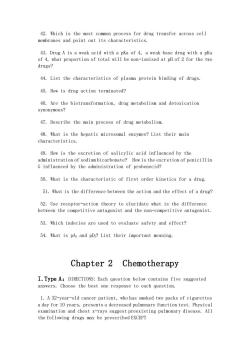
42.Which is the most common process for drug transfer across cell membranes and point out its characteristics. 43.Drug A is a weak acid with a pKa of 4,a weak base drug with a pKa of 4,what proportion of total will be non-ionised at pH of 2 for the two drugs'? 44.List the characteristics of plasma protein binding of drugs. 45.How is drug action terminated? 46.Are the biotransformation,drug metabolism and detoxication synonymous? 47.Describe the main process of drug metabolism. 48.What is the hepatic microsomal enzymes?List their main characteristics. 49.How is the excretion of salicylic acid influenced by the administration of sodiumbicarbonate?How is the excretion of penicillin G influenced by the administration of probenecid? 50.What is the characteristic of first order kinetics for a drug. 51.What is the difference between the action and the effect of a drug? 52.Use receptor-action theory to elucidate what is the difference between the competitive antagonist and the non-competitive antagonist. 53.Which indecies are used to evaluate safety and effect? 54.What is pAe and pDa?List their important meaning. Chapter 2 Chemotherapy I.Type A:DIRECTIONS:Each question below contains five suggested answers.Choose the best one response to each question. 1 A 32-vear-old cancer patient.who has smoked two packs of cigarettes kamination and chest xrays suggest preexisting pulmonary disease.All the following drugs may be prescribed EXCEPT
42. Which is the most common process for drug transfer across cell membranes and point out its characteristics. 43. Drug A is a weak acid with a pKa of 4, a weak base drug with a pKa of 4, what proportion of total will be non-ionised at pH of 2 for the two drugs? 44. List the characteristics of plasma protein binding of drugs. 45. How is drug action terminated? 46. Are the biotransformation, drug metabolism and detoxication synonymous? 47. Describe the main process of drug metabolism. 48. What is the hepatic microsomal enzymes? List their main characteristics. 49. How is the excretion of salicylic acid influenced by the administration of sodium bicarbonate? How is the excretion of penicillin G influenced by the administration of probenecid? 50. What is the characteristic of first order kinetics for a drug. 51. What is the difference between the action and the effect of a drug? 52. Use receptor-action theory to elucidate what is the difference between the competitive antagonist and the non-competitive antagonist. 53. Which indecies are used to evaluate safety and effect? 54. What is pA2 and pD2? List their important meaning. Chapter 2 Chemotherapy I.Type A:DIRECTIONS: Each question below contains five suggested answers. Choose the best one response to each question. 1. A 32-year-old cancer patient, who has smoked two packs of cigarettes a day for 10 years, presents a decreased pulmonary function test. Physical examination and chest x-rays suggest preexisting pulmonary disease. All the following drugs may be prescribed EXCEPT
按次数下载不扣除下载券;
注册用户24小时内重复下载只扣除一次;
顺序:VIP每日次数-->可用次数-->下载券;
- 《药理学》课程教学资源(作业习题)习题集一(习题).doc
- 《药理学》课程授课教案(讲义)Chapter 36 -41.doc
- 重庆医科大学:《药理学》课程教学大纲(72学时).doc
- 《药物分析》课程教学资源(PPT课件)药物分析实验讲稿.ppt
- 《药物分析》课程教学资源(PPT课件)第16章 药品质量控制中现代分析方法的进展.ppt
- 《药物分析》课程教学资源(PPT课件)第15章 药品质量标准的制定.ppt
- 《药物分析》课程教学资源(PPT课件)第14章 中药制剂分析.ppt
- 《药物分析》课程教学资源(PPT课件)第13章 生物制品分析概论.ppt
- 《药物分析》课程教学资源(PPT课件)第12章 制剂分析.ppt
- 《药物分析》课程教学资源(PPT课件)第11章 抗生素类药物分析 The Analysis of Aantibiotic drugs.ppt
- 《药物分析》课程教学资源(PPT课件)第10章 甾体激素类药物分析 The analysis of Steroid Hormon Drugs.ppt
- 《药物分析》课程教学资源(PPT课件)第9章 维生素类药物分析 The Analysis of Vitamins.ppt
- 《药物分析》课程教学资源(PPT课件)第8章 杂环类药物分析 The Analysis of Heterocyclic drugs.ppt
- 《药物分析》课程教学资源(PPT课件)第6章 芳酸及其酯类药物的分析.ppt
- 《药物分析》课程教学资源(PPT课件)第5章 巴比妥类药物的分析 Analysis of Barbitals Drugs.ppt
- 《药物分析》课程教学资源(PPT课件)第4章 药物定量分析与分析方法验证.ppt
- 《药物分析》课程教学资源(PPT课件)第3章 药物的杂质检查.ppt
- 《药物分析》课程教学资源(PPT课件)第1章 药典概况.ppt
- 《药物分析》课程教学资源(PPT课件)绪论 Pharmaceutical Analysis(重庆医科大学:范琦).ppt
- 《药物分析》课程试卷习题(含答案)药物分析习题二.doc
- 《药理学》课程教学资源(作业习题)习题集二(习题).doc
- 《药理学》课程教学资源(作业习题)习题集一(参考答案).doc
- 《药理学》课程教学资源(作业习题)习题集二(参考答案).doc
- 《药理学》课程教学资源(作业习题)习题集三(英文,参考答案).doc
- 《药理学》课程授课教案(讲义)抗结核病、抗疟药.doc
- 《药理学》课程授课教案(讲义)抗阿米巴药、抗恶性肿瘤药.doc
- 《药理学》课程授课教案(讲义)合成抗菌药、抗真菌药.doc
- 《药理学》课程授课教案(讲义)作用于血液系统药物.doc
- 《药理学》课程授课教案(讲义)抗高血压药物.doc
- 《药理学》课程授课教案(讲义)调血脂药物.doc
- 《药理学》课程授课教案(讲义)抗心绞痛药物.doc
- 《药理学》课程授课教案(讲义)抗心律失常药物.doc
- 《药理学》课程授课教案(讲义)利尿药物.doc
- 《药理学》课程授课教案(讲义)强心药物.doc
- 《药理学》课程授课教案(讲义)肾上腺皮质激素药物.doc
- 《药理学》课程授课教案(讲义)镇痛解热镇痛.doc
- 《药理学》课程授课教案(讲义)抗生素.doc
- 《药理学》课程授课教案(讲义)抗慢性心功能不全.doc
- 《药理学》课程授课教案(讲义)抗糖尿病药.doc
- 《药理学》课程授课教案(讲义)抗组胺药.doc
